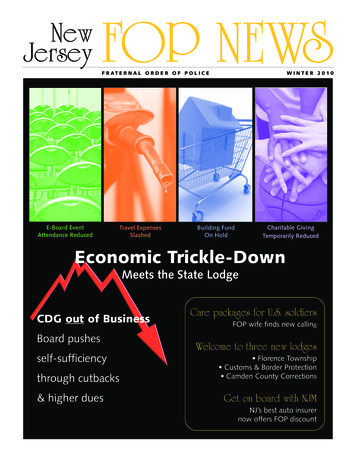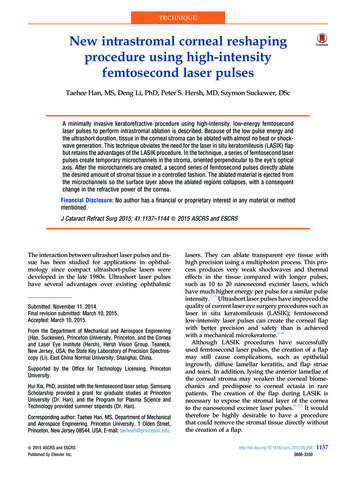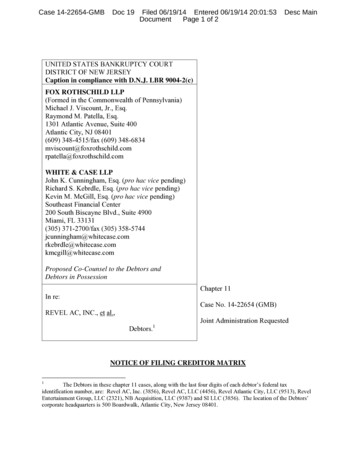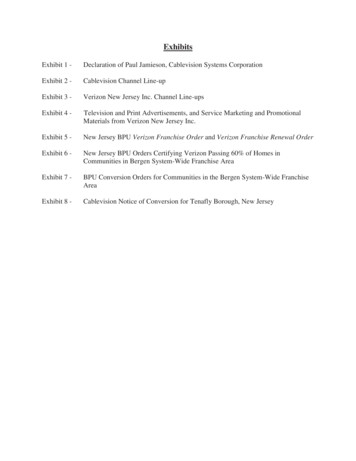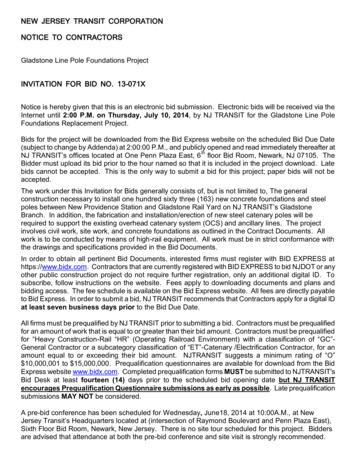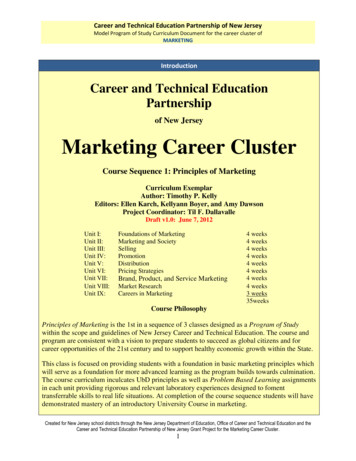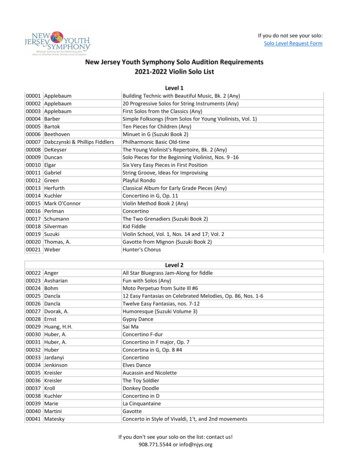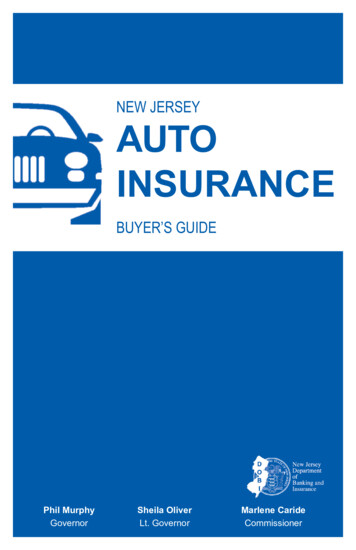
Transcription
NEW JERSEYSTUDENT LEARNING STANDARDS FORMathematics
New Jersey Student Learning Standards for MathematicsTable of ContentsStandards for Mathematical PracticeStandards for Mathematical Content3Kindergarten7Grade 111Grade 216Grade 321Grade 427Grade 533Grade 639Grade 746Grade 853High School — Introduction59High School — Number and Quantity60High School — Algebra64High School — Functions70High School — Modeling75High School — Geometry77High School — Statistics and Probability84Notes on Courses and TransitionsGlossarySample of Works Consulted8990962
New Jersey Student Learning Standards for MathematicsMathematics Standards for Mathematical PracticeThe Standards for Mathematical Practice describe varieties of expertise that mathematicseducators at all levels should seek to develop in their students. These practices rest on important“processes and proficiencies” with longstanding importance in mathematics education. The firstof these are the NCTM process standards of problem solving, reasoning and proof,communication, representation, and connections. The second are the strands of mathematicalproficiency specified in the National Research Council’s report Adding It Up: adaptive reasoning,strategic competence, conceptual understanding (comprehension of mathematical concepts,operations and relations), procedural fluency (skill in carrying out procedures flexibly, accurately,efficiently and appropriately), and productive disposition (habitual inclination to see mathematicsas sensible, useful, and worthwhile, coupled with a belief in diligence and one’s own efficacy).1 Make sense of problems and persevere in solving them.Mathematically proficient students start by explaining to themselves the meaning of a problemand looking for entry points to its solution. They analyze givens, constraints, relationships, andgoals. They make conjectures about the form and meaning of the solution and plan a solutionpathway rather than simply jumping into a solution attempt. They consider analogous problems,and try special cases and simpler forms of the original problem in order to gain insight into itssolution. They monitor and evaluate their progress and change course if necessary. Olderstudents might, depending on the context of the problem, transform algebraic expressions orchange the viewing window on their graphing calculator to get the information they need.Mathematically proficient students can explain correspondences between equations, verbaldescriptions, tables, and graphs or draw diagrams of important features and relationships, graphdata, and search for regularity or trends. Younger students might rely on using concrete objectsor pictures to help conceptualize and solve a problem. Mathematically proficient students checktheir answers to problems using a different method, and they continually ask themselves, “Doesthis make sense?” They can understand the approaches of others to solving complex problemsand identify correspondences between different approaches.2 Reason abstractly and quantitatively.Mathematically proficient students make sense of quantities and their relationships in problemsituations. They bring two complementary abilities to bear on problems involving quantitativerelationships: the ability to decontextualize—to abstract a given situation and represent itsymbolically and manipulate the representing symbols as if they have a life of their own, withoutnecessarily attending to their referents—and the ability to contextualize, to pause as neededduring the manipulation process in order to probe into the referents for the symbols involved.Quantitative reasoning entails habits of creating a coherent representation of the problem athand; considering the units involved; attending to the meaning of quantities, not just how tocompute them; and knowing and flexibly using different properties of operations and objects.3 Construct viable arguments and critique the reasoning of others.Mathematically proficient students understand and use stated assumptions, definitions, andpreviously established results in constructing arguments. They make conjectures and build alogical progression of statements to explore the truth of their conjectures. They are able toanalyze situations by breaking them into cases, and can recognize and use counterexamples.They justify their conclusions, communicate them to others, and respond to the arguments ofothers. They reason inductively about data, making plausible arguments that take into account3
New Jersey Student Learning Standards for Mathematicsthe context from which the data arose. Mathematically proficient students are also able tocompare the effectiveness of two plausible arguments, distinguish correct logic or reasoningfrom that which is flawed, and—if there is a flaw in an argument—explain what it is. Elementarystudents can construct arguments using concrete referents such as objects, drawings, diagrams,and actions. Such arguments can make sense and be correct, even though they are notgeneralized or made formal until later grades. Later, students learn to determine domains towhich an argument applies. Students at all grades can listen or read the arguments of others,decide whether they make sense, and ask useful questions to clarify or improve the arguments.4 Model with mathematics.Mathematically proficient students can apply the mathematics they know to solve problemsarising in everyday life, society, and the workplace. In early grades, this might be as simple aswriting an addition equation to describe a situation. In middle grades, a student might applyproportional reasoning to plan a school event or analyze a problem in the community. By highschool, a student might use geometry to solve a design problem or use a function to describehow one quantity of interest depends on another. Mathematically proficient students who canapply what they know are comfortable making assumptions and approximations to simplify acomplicated situation, realizing that these may need revision later. They are able to identifyimportant quantities in a practical situation and map their relationships using such tools asdiagrams, two-way tables, graphs, flowcharts and formulas. They can analyze those relationshipsmathematically to draw conclusions. They routinely interpret their mathematical results in thecontext of the situation and reflect on whether the results make sense, possibly improving themodel if it has not served its purpose.5 Use appropriate tools strategically.Mathematically proficient students consider the available tools when solving a mathematicalproblem. These tools might include pencil and paper, concrete models, a ruler, a protractor, acalculator, a spreadsheet, a computer algebra system, a statistical package, or dynamic geometrysoftware. Proficient students are sufficiently familiar with tools appropriate for their grade orcourse to make sound decisions about when each of these tools might be helpful, recognizingboth the insight to be gained and their limitations. For example, mathematically proficient highschool students analyze graphs of functions and solutions generated using a graphing calculator.They detect possible errors by strategically using estimation and other mathematical knowledge.When making mathematical models, they know that technology can enable them to visualize theresults of varying assumptions, explore consequences, and compare predictions with data.Mathematically proficient students at various grade levels are able to identify relevant externalmathematical resources, such as digital content located on a website, and use them to pose orsolve problems. They are able to use technological tools to explore and deepen theirunderstanding of concepts.6 Attend to precision.Mathematically proficient students try to communicate precisely to others. They try to use cleardefinitions in discussion with others and in their own reasoning. They state the meaning of thesymbols they choose, including using the equal sign consistently and appropriately. They arecareful about specifying units of measure, and labeling axes to clarify the correspondence withquantities in a problem. They calculate accurately and efficiently, express numerical answers witha degree of precision appropriate for the problem context. In the elementary grades, studentsgive carefully formulated explanations to each other. By the time they reach high school theyhave learned to examine claims and make explicit use of definitions.4
New Jersey Student Learning Standards for Mathematics7 Look for and make use of structure.Mathematically proficient students look closely to discern a pattern or structure. Young students,for example, might notice that three and seven more is the same amount as seven and threemore, or they may sort a collection of shapes according to how many sides the shapes have.Later, students will see 7 8 equals the well remembered 7 5 7 3, in preparation forlearning about the distributive property. In the expression x2 9x 14, older students can see the14 as 2 7 and the 9 as 2 7. They recognize the significance of an existing line in a geometricfigure and can use the strategy of drawing an auxiliary line for solving problems. They also canstep back for an overview and shift perspective. They can see complicated things, such as somealgebraic expressions, as single objects or as being composed of several objects. For example,they can see 5 – 3(x – y)2 as 5 minus a positive number times a square and use that to realize thatits value cannot be more than 5 for any real numbers x and y.8 Look for and express regularity in repeated reasoning.Mathematically proficient students notice if calculations are repeated, and look both for generalmethods and for shortcuts. Upper elementary students might notice when dividing 25 by 11 thatthey are repeating the same calculations over and over again, and conclude they have arepeating decimal. By paying attention to the calculation of slope as they repeatedly checkwhether points are on the line through (1, 2) with slope 3, middle school students might abstractthe equation (y – 2)/(x – 1) 3. Noticing the regularity in the way terms cancel when expanding (x– 1)(x 1), (x – 1)(x2 x 1), and (x – 1)(x3 x2 x 1) might lead them to the general formula forthe sum of a geometric series. As they work to solve a problem, mathematically proficientstudents maintain oversight of the process, while attending to the details. They continuallyevaluate the reasonableness of their intermediate results.5
New Jersey Student Learning Standards for MathematicsConnecting the Standards for Mathematical Practice to the Standards forMathematical ContentThe Standards for Mathematical Practice describe ways in which developing student practitionersof the discipline of mathematics increasingly ought to engage with the subject matter as theygrow in mathematical maturity and expertise throughout the elementary, middle and high schoolyears. Designers of curricula, assessments, and professional development should all attend to theneed to connect the mathematical practices to mathematical content in mathematics instruction.The Standards for Mathematical Content are a balanced combination of procedure andunderstanding. Expectations that begin with the word “understand” are often especially goodopportunities to connect the practices to the content. Students who lack understanding of a topicmay rely on procedures too heavily. Without a flexible base from which to work, they may be lesslikely to consider analogous problems, represent problems coherently, justify conclusions, applythe mathematics to practical situations, use technology mindfully to work with the mathematics,explain the mathematics accurately to other students, step back for an overview, or deviate froma known procedure to find a shortcut. In short, a lack of understanding effectively prevents astudent from engaging in the mathematical practices.In this respect, those content standards, which set an expectation of understanding, are potential“points of intersection” between the Standards for Mathematical Content and the Standards forMathematical Practice. These points of intersection are intended to be weighted toward centraland generative concepts in the school mathematics curriculum that most merit the time,resources, innovative energies, and focus necessary to qualitatively improve the curriculum,instruction, assessment, professional development, and student achievement in mathematics.6
New Jersey Student Learning Standards for MathematicsMathematics KindergartenIn Kindergarten, instructional time should focus on two critical areas: (1) representingand comparing whole numbers, initially with sets of objects; (2) describing shapes andspace. More learning time in Kindergarten should be devoted to number than to othertopics.(1) Students use numbers, including written numerals, to represent quantities and tosolve quantitative problems, such as counting objects in a set; counting out a givennumber of objects; comparing sets or numerals; and modeling simple joining andseparating situations with sets of objects, or eventually with equations such as 5 2 7and 7 – 2 5. (Kindergarten students should see addition and subtraction equations, andstudent writing of equations in kindergarten is encouraged, but it is not required.)Students choose, combine, and apply effective strategies for answering quantitativequestions, including quickly recognizing the cardinalities of small sets of objects, countingand producing sets of given sizes, counting the number of objects in combined sets, orcounting the number of objects that remain in a set after some are taken away.(2) Students describe their physical world using geometric ideas (e.g., shape, orientation,spatial relations) and vocabulary. They identify, name, and describe basic twodimensional shapes, such as squares, triangles, circles, rectangles, and hexagons,presented in a
arising in everyday life, society, and the workplace. In early grades, this might be as simple as writing an addition equation to describe a situation. In middle grades, a student might apply proportional reasoning to plan a school event or analyze aproblem in the community. By high school, a student might use geometry to solve a design problem or use a function to describe how one quantity of .
